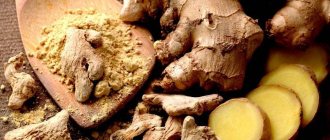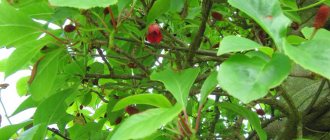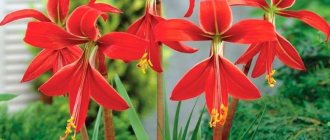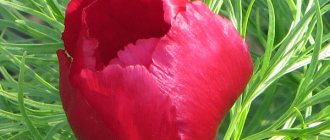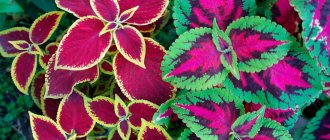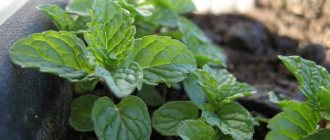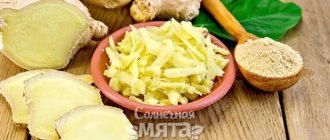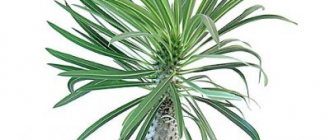How to choose ginger root for planting
When purchasing ginger, make sure that it is not wrinkled, soft, or moldy.
The ginger you are going to use should be firm and have green shoots that look a lot like horns.
If the ginger root has multiple shoots, the root can be cut and placed in different pots to create multiple plants.
It is advisable to buy ginger in a store that sells organic products, since in supermarkets, as a rule, it is sprayed with a growth inhibitor to slow down the germination process, and ginger can also be treated with pesticides and fungicides.
While this doesn't mean you can't grow supermarket ginger, there's still a chance it will grow.
If there are no green shoots on the root yet, but there are already swollen buds, you can also buy this kind of ginger ; it will germinate in the soil.
Possible problems
Difficulties when growing ginger arise quite rarely. However, due to exposure to warm air, spider mites may appear on the plant. If the plant is not helped in time, it may die. To combat the pest, it is worth providing the ginger with a large amount of moisture and treating it with chemicals once a week.
Today we answered the question whether it is possible to grow ginger in Russia. As we can see, this southern plant grows very successfully both at home and outdoors. Therefore, this is a great reason to start growing it in order to delight your household with aromatic pastries and delicious tea all year round!
How to grow ginger at home
As the ginger grows, more and more rhizomes form, giving you a new harvest of ginger.
To remove pesticides from ginger, soak it in water overnight before planting.
Growing temperature
The optimal temperature for growing ginger at home is 20-21 degrees, but less than 10 degrees.
Both direct sunlight for many hours and low temperatures can impair its growth.
Avoid placing the plant near air conditioners or radiators.
What kind of pot do you need?
The pot in which the ginger will be planted, the width of the pot should be at least 2 times larger than the length of the root you are planting.
Ginger grows in width underground , and the above-ground part grows up to 60-90 cm in height.
The depth of the pot should be about 40 cm.
You need to put drainage on the bottom of the pot , it could be expanded clay, pebbles or something similar.
Drainage is needed to prevent waterlogging.
What kind of soil is needed?
Ginger prefers fertile soil.
Fill the pot with 1 part compost or humus and 3 parts soil.
If you don't have good soil, or if you grow ginger in regular garden soil, it will need to be fertilized regularly.
For fertilizer, it is advisable to use organic fertilizers, such as vermicompost, nettle fertilizer, wood ash, etc.
Preparing ginger for planting
Now you need to prepare the ginger for planting.
If it has several sprouts or swollen buds, cut it so that there is one or more buds on each piece.
More than one bud on a ginger gives more guarantee that the root will sprout.
It is advisable to plant each such piece in a separate pot if the pot is small in width.
Planting ginger in the soil
When planting, the rhizome is placed horizontally in the soil, leaving shoots on the surface.
How to water ginger?
At the very beginning, after planting the ginger root, it is recommended to mix water for irrigation with vermicompost (earthworm humus).
It is best to water little and often , making sure the soil is always moist but never becomes swampy.
Never pour water directly on the root ; water around the root.
If the soil does become waterlogged, the ginger needs to be transplanted into another pot with new soil so that the roots do not rot.
Ginger care
After planting, the soil should be kept slightly moist.
At first, the plant should be in a place with a small amount of light.
You need to water so that the water does not fall on the root itself, but moistens the soil around it.
When to harvest?
3-4 months after the ginger begins to grow, the first harvest can be harvested.
But after 3-4 months, the ginger will be at the stage of milky ripeness.
But in general, the readiness of the harvest is determined by the leaves; when they turn yellowish , it is time to harvest.
It takes approximately 10 months from planting until the leaves turn yellow.
To do this, carefully examine the ground with your hand until you find the ginger roots, take as much as you need and cover everything back with soil so that the ginger can continue to grow.
How to care?
Ginger needs to be cared for regularly. In order for the plant to grow strong and healthy, growth conditions must be close to natural. In addition to watering, the plant needs to be fed and the crown trimmed. Pruning is necessary if ginger is grown for its healing roots.
How often to water?
The soil in the pot should be constantly moist, but the plant should not be flooded; water should not stagnate in the pan. Ginger, planted in the spring, reaches the active growth stage in the summer. During this period, the soil should not be allowed to dry out.
Fallen leaves will be a signal of a lack of water. If there is too much water, the roots will begin to rot and the leaves will turn yellow. For irrigation, settled water at room temperature is used. After watering, the soil should be loosened.
How to separate ginger roots?
Ginger is divided in order to obtain new plants or simply to separate old rhizomes from new ones and increase the amount of harvest.
Root separation is carried out when the plant is at least 3 years old and when the pot is already filled with roots so that they do not have enough space to develop.
Another sign that it is time to separate the roots is the appearance of ginger roots above the surface of the soil.
To separate the roots, dig them carefully without damaging them.
Use a sharp knife to cut off individual rhizomes.
Check each root for damage, rot or pests.
The roots should not be damaged.
As a result, you need to select healthy roots that have at least a few eyes or growth nodes.
They will be a source of new plant growth.
After separating the ginger, they should be planted in the soil immediately, and some of them can be set aside for food use.
Growing in open ground
If you are the happy owner of several acres, then you can try growing ginger in open ground. It needs to be planted in a greenhouse to avoid the risk of freezing the tender southerner.
Otherwise, the growing technology is not too different from growing in an apartment:
- After providing drainage and a soil mixture suitable for root crops, regularly water and spray the above-ground part of the plant.
- Don’t forget about feeding: well-manured soil and potassium fertilizers will help to grow a large rhizome with many young roots, which will become suitable planting material next season.
- In our climate, ginger will need to be harvested in mid or late August.
- A week before harvesting, stop watering.
- Cut off any wilting stems.
- Immediately divide the overgrown rhizome into parts, separating those intended for planting and sending them for storage.
- Freeze or dry parts to be used in a well-ventilated area.
Important! Ginger does not like direct sunlight and very high temperatures. If you move a houseplant outside, provide it with shade to avoid burning the delicate leaves.
If the ginger is planted in a greenhouse, make sure that taller plants grow nearby or make an awning that will protect your southerner from burns.
Why did the ginger leaves turn brown?
Darkening of ginger leaves may be a sign that the plant is not comfortable in its growing conditions.
One of these unfavorable conditions may be a lack of watering and the ginger lacks moisture .
Brown ginger leaves can be a sign of sunburn , and signs of sunburn can also include crispy, papery leaves.
Also, the cause of brown leaves can be a disease, after which ginger usually does not survive.
Diseased ginger roots can be recognized by dry rot; on the roots there may be: bacterial silt, soft rot and other unpleasant signs of the disease that are clearly visible.
Such a plant can no longer be saved, so they need to be disposed of.
Diseases and pests of ginger
Ginger is not susceptible to diseases, but pests in open ground often overwhelm this plant. These can be slugs, nematodes, thrips and the most dangerous pest - spider mites.
Dry weather and improper watering contribute to the attack of spider mites, so it is necessary to immediately increase the air humidity by spraying. Also, in case of tick infestation, it is necessary to resort to spraying with acaricides “Fitoverm”, “Kleschevit”, Fufanon”, repeated 3 times every 7 days.
To prevent ginger from being overcome by nematodes, preventive measures are taken before planting - the soil is spilled with boiling water. When pests appear, the soil is treated with the potent biological preparation “Nematophagin”, but it must be used carefully.
To get rid of slugs, sprinkle the soil next to the plantings with red pepper, mustard, crushed eggshells or shell rock.
Ginger diseases
Ginger does not have many diseases , so it will not be difficult to determine which disease your plant has.
Root nematode
With root nematode, the roots will appear cracked and slightly shrunken.
Bacterial wilt
In this disease, bacteria penetrate the vascular tissue of ginger plants and multiply until water no longer flows to the shoots and leaves.
Bacterial wilt manifests itself as symptoms of lack of water, despite adequate watering.
The leaves begin to turn yellow.
What kind of plant is this?
Ginger is a medicinal perennial plant of the ginger family, the edible part of which is its root. The above-ground part of the plant resembles sedge grass. Initially, it grew naturally only in Western India and Southeast Asia.
Ginger is quite common in countries with tropical climates - Japan, Vietnam, Brazil and Argentina. The closest relatives of ginger are cardamom, turmeric, tulip and ginger lily.
Ginger now practically does not grow in the wild. This is a typical garden crop.
The plant has lanceolate leaves, long and strong stems up to 1-1.5 m tall. Peduncles up to 30 cm long, with small leaves.
The flowers are collected in apical spikes and are located in the axils of the bracts. Ginger is a flowering plant, but never bears fruit. The plant reproduces by roots, powerful and tuberous. Falling leaves indicate that the ginger is ripe.
Useful properties of ginger and contraindications
The beneficial properties of ginger have been known since ancient times. It is beneficial and helps to cope with many problems, which include:
- Flatulence and diarrhea.
- Food poisoning, even mushrooms.
- Inadequate digestion of food perfectly prevents the accumulation of toxins in the intestines, which only poison the body.
- Getting rid of helminths and other parasites.
- Pathologies of the oral cavity.
- Skin diseases and allergies.
- Reducing cholesterol.
- Improving the condition of blood vessels and preventing the formation of blood clots.
- Increases immunity.
- Relief from joint and muscle pain, swelling and sprains.
- Reducing stomach cramps.
Ginger helps women recover from infertility. During menstruation it relieves cramps.
Harm and contraindications for ginger, despite its benefits, are also present, like with any plant. Restrictions on use include:
- If you have a sore throat or a cold, if you have a fever, you cannot treat with ginger - it can cause the temperature to rise even higher.
- Ginger is contraindicated for gastritis, stomach and duodenal ulcers, because the spice irritates the mucous membranes. It is also prohibited to take it if you have oncology - it helps accelerate tumor growth.
- Ginger is contraindicated for liver diseases and cholelithiasis - it has choleretic properties.
- Ginger root thins the blood. But it should be taken with caution if you have frequent nosebleeds or hemorrhoids.
- Seasoning increases blood pressure.
- You should not use the spice at night - it can cause insomnia.
It is forbidden to take the seasoning in the second half of pregnancy and during breastfeeding. The spice juice penetrates into breast milk and prevents the baby from sleeping.
How to plant ginger at home Movie 1
We grow ginger according to all the rules
To plant ginger at home in a pot, no special preparation or special skills are required. It is not particularly demanding, so even a person with no experience can plant it. You just need to follow the procedure and advice from experts on how to plant ginger at home.
Ginger flowers
Place of cultivation
It is necessary to determine in advance where the flower pot will be located. A tropical plant requires warmth and sufficient sunlight. But direct exposure to the sun is undesirable, as is a draft, as well as cold air.
Boarding time
You can grow ginger at home from the root at any time of the year. There are no restrictions for planting in the ground. But the best results are obtained by planting in the cold season. The most preferable time is winter, the most optimal time is the second half of February - early March.
Varieties
Since the 15th century, it is not a wild plant that has been used, but a cultivated one. Selection work continues today. Experts are trying to develop varieties with larger, juicier and tastier rhizomes.
Ginger is a plant with a dense, thick root, covered with several layers of leaves, among which are internodes of adventitious roots.
The most developed root “shoots out” two or three erect, not pubescent, long (up to 2 m) and seemingly rounded above-ground stems.
Ginger flowers can have different colors, depending on the type of plant.
The most common colors are orange-yellow and brown, less often red. Flowers in the form of spikes are crowned with ginger shoots.
Not only the flower color, but also the color of the pulp depends on the variety: it can be light, greenish, orange, brownish, yellowish with blue dots.
The aroma also has several options: you can catch notes of citrus, grass or kerosene. But the pungency of taste is essentially the same for all varieties.
All varieties of ginger, depending on the processing method, are divided into 2 main ones used in trade.
There are also taste differences between them:
- Barbados or Black Ginger is a variety with a pronounced, pungent taste. To obtain raw materials that have a commercial appearance, the rhizomes, without removing the peel, are poured with boiling water.
- Bengal or White ginger - the taste is less pungent, the aroma is weakened. The rhizomes are cleaned with a brush, then kept in a 2% solution of sulfurous acid.
